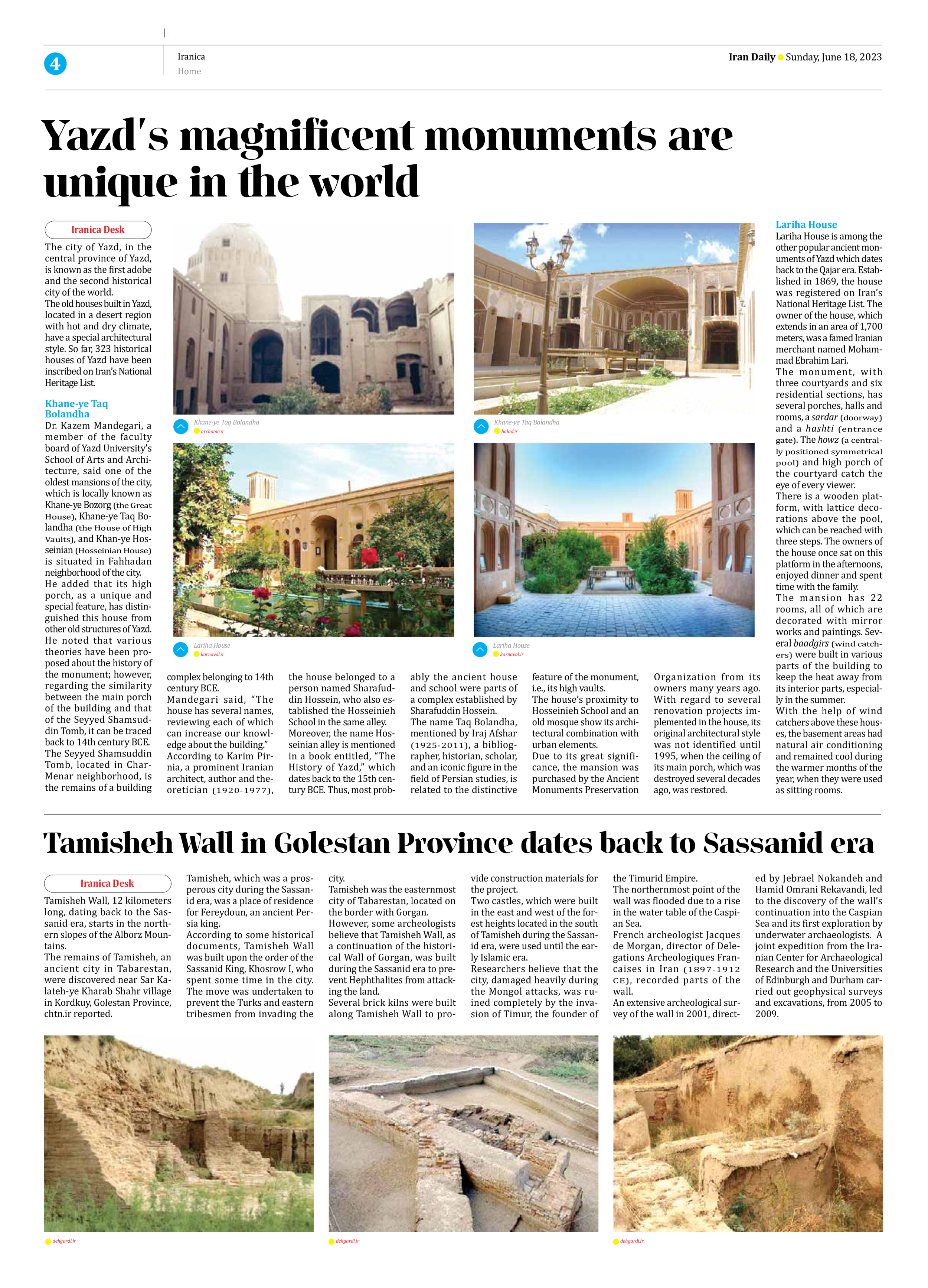
Yazd’s magnificent monuments are unique in the world
The city of Yazd, in the central province of Yazd, is known as the first adobe and the second historical city of the world.
The old houses built in Yazd, located in a desert region with hot and dry climate, have a special architectural style. So far, 323 historical houses of Yazd have been inscribed on Iran’s National Heritage List.
Khane-ye Taq Bolandha
Dr. Kazem Mandegari, a member of the faculty board of Yazd University’s School of Arts and Architecture, said one of the oldest mansions of the city, which is locally known as Khane-ye Bozorg (the Great House), Khane-ye Taq Bolandha (the House of High Vaults), and Khan-ye Hosseinian (Hosseinian House) is situated in Fahhadan neighborhood of the city.
He added that its high porch, as a unique and special feature, has distinguished this house from other old structures of Yazd.
He noted that various theories have been proposed about the history of the monument; however, regarding the similarity between the main porch of the building and that of the Seyyed Shamsuddin Tomb, it can be traced back to 14th century BCE.
The Seyyed Shamsuddin Tomb, located in Char-Menar neighborhood, is the remains of a building complex belonging to 14th century BCE.
Mandegari said, “The house has several names, reviewing each of which can increase our knowledge about the building.”
According to Karim Pirnia, a prominent Iranian architect, author and theoretician (1920-1977), the house belonged to a person named Sharafuddin Hossein, who also established the Hosseinieh School in the same alley.
Moreover, the name Hosseinian alley is mentioned in a book entitled, “The History of Yazd,” which dates back to the 15th century BCE. Thus, most probably the ancient house and school were parts of a complex established by Sharafuddin Hossein.
The name Taq Bolandha, mentioned by Iraj Afshar (1925-2011), a bibliographer, historian, scholar, and an iconic figure in the field of Persian studies, is related to the distinctive feature of the monument, i.e., its high vaults.
The house’s proximity to Hosseinieh School and an old mosque show its architectural combination with urban elements.
Due to its great significance, the mansion was purchased by the Ancient Monuments Preservation Organization from its owners many years ago. With regard to several renovation projects implemented in the house, its original architectural style was not identified until 1995, when the ceiling of its main porch, which was destroyed several decades ago, was restored.
Lariha House
Lariha House is among the other popular ancient monuments of Yazd which dates back to the Qajar era. Established in 1869, the house was registered on Iran’s National Heritage List. The owner of the house, which extends in an area of 1,700 meters, was a famed Iranian merchant named Mohammad Ebrahim Lari.
The monument, with three courtyards and six residential sections, has several porches, halls and rooms, a sardar (doorway) and a hashti (entrance gate). The howz (a centrally positioned symmetrical pool) and high porch of the courtyard catch the eye of every viewer.
There is a wooden platform, with lattice decorations above the pool, which can be reached with three steps. The owners of the house once sat on this platform in the afternoons, enjoyed dinner and spent time with the family.
The mansion has 22 rooms, all of which are decorated with mirror works and paintings. Several baadgirs (wind catchers) were built in various parts of the building to keep the heat away from its interior parts, especially in the summer.
With the help of wind catchers above these houses, the basement areas had natural air conditioning and remained cool during the warmer months of the year, when they were used as sitting rooms.







